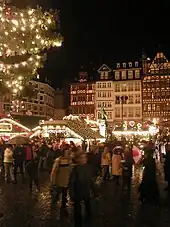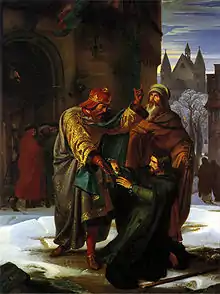Frankfurt Christmas Market
The Frankfurt Christmas Market (German: Frankfurter Weihnachtsmarkt[1]) is one of the oldest Christmas markets (also known as "Weihnachtsmärkts") in Germany[2] with origins that date back to 1393.[3] It is an annual outdoor Christmas market held in central Frankfurt, Hesse, Germany.[4] The market is open during the period of Advent (from late November and continues until just before Christmas on the 22nd of December). It is visited by approximately three million visitors each year.

The market occupies a large area of the old town in central Frankfurt, including Friedrich-Stoltze-Platz, Hauptwache (to the north), Mainkai, Paulsplatz, and Römerberg (to the south).[1]
There are a number of affiliated markets, including in Birmingham, England.[2]
History
In 1393, the first Christmas market in Frankfurt, Germany was documented. During this period, Christmas lacked the same cultural significance as it does today. The purpose of the market was to provide citizens with the opportunity to purchase essential items prior to the onset of winter. Unlike fairs, only those who resided in Frankfurt were permitted to establish stalls.[5][6]
During the Middle Ages, mystery plays were performed at Christmas Markets, which may have originated in 941 CE. At that time, King Otto I spent Christmas at the Royal Palace of Frankfurt and celebrated Christmas Mass at the Salvatorkirche. As King Otto departed the church, his estranged brother, Heinrich, fell to his knees and pleaded for forgiveness, which Otto granted. The scene was later immortalised in a painting by Alfred Rethel in 1840, which is now housed in the Historical Museum.

During the 19th century, the Christmas market began to take shape and take on the form that it is today. It became increasingly common to decorate and display Christmas trees, with Saxon houses being granted the right to sell them in the Roman halls. In accordance with the ruling of the magistrate, only items related to the Christmas season were permitted to be sold, such as toys for children, Christmas trees, gingerbread, and other confectionery goods.
Illustrations from the mid-19th century depict a scene similar to the one seen today at Römerberg – a bustling market filled with small stalls. In 1851, author Heinrich Hoffmann published his Christmas fairy tale, King Nutcracker and Poor Reinhold. The original edition was illustrated with a handwritten drawing by Hoffmann himself, depicting the Frankfurt Christmas market. The tale follows a sick boy's dream, in which he is led to a toy kingdom by King Nutcracker, and upon waking finds the same toys under his Christmas tree. This is the earliest known story to feature a nutcracker as a prominent character. Shortly after, in the 1870s, Seiffen in the Ore Mountains began producing turned nutcrackers, which are now a popular item available at Christmas markets.
During the Second World War, the historic setting of the Frankfurt Christmas market was destroyed during Allied air raids. In the post-war period, the market was held in various locations around the city, as the Römerberg was a construction site due to the erection of the subway system in the late 1960s and early 1970s. By the 1970s, the market was able to return to its traditional location. Following the reconstruction of the East Row in the Saturday Mountain in 1983, it has become a popular tourist attraction.[6]
In 2020, due to the COVID-19 pandemic in Germany, the city of Frankfurt cancelled the Christmas market planned for November 23 to December 22[7] and, in its place, Tourismus+Congress GmbH Frankfurt am Main made digital content available as an online Christmas market on the Internet.
See also
References
- Frankfurter Weihnachtsmarkt – Frankfurt Christmas Market 23.11. – 22.12.2014, Frankfurt am Main: Tourismus+Congress GmbH, 2014
- "Frankfurt Christmas Market". germany-insider-facts.com. Retrieved 22 December 2014.
- "Frankfurt Christmas Markets in Great Britain". frankfurt-tourismus.de. Germany. Archived from the original on 27 December 2014. Retrieved 22 December 2014.
- "Frankfurt Christmas Market". frankfurt-tourismus.de. Germany. Retrieved 18 December 2015.
- "History of Frankfurt's Christmas Market". Frankfurt Tourism. Retrieved 2023-05-10.
- "Facts about Frankfurt Christmas Market 2019". GermanyInsiderFacts. Retrieved 2023-05-10.
- Kehler, Marie Lisa. "Frankfurt: Corona sorgt für Weihnachtsmarkt-Aus". FAZ.NET (in German). ISSN 0174-4909. Retrieved 2023-05-10.